美音发音技巧
- 格式:doc
- 大小:970.50 KB
- 文档页数:26
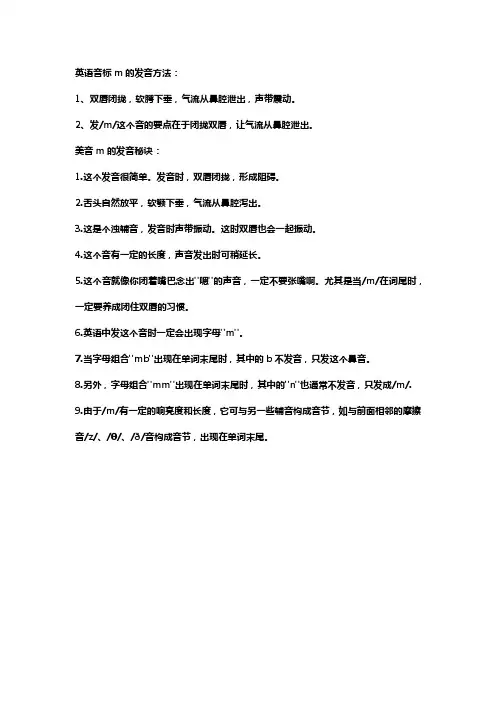
英语音标m的发音方法:
1、双唇闭拢,软腭下垂,气流从鼻腔泄出,声带震动。
2、发/m/这个音的要点在于闭拢双唇,让气流从鼻腔泄出。
美音m的发音秘诀:
1.这个发音很简单。
发音时,双唇闭拢,形成阻碍。
2.舌头自然放平,软颚下垂,气流从鼻腔泻出。
3.这是个浊辅音,发音时声带振动。
这时双唇也会一起振动。
4.这个音有一定的长度,声音发出时可稍延长。
5.这个音就像你闭着嘴巴念出"嗯"的声音,一定不要张嘴啊。
尤其是当/m/在词尾时,一定要养成闭住双唇的习惯。
6.英语中发这个音时一定会出现字母"m"。
7.当字母组合"mb"出现在单词末尾时,其中的b不发音,只发这个鼻音。
8.另外,字母组合"mm"出现在单词末尾时,其中的"n"也通常不发音,只发成/m/.
9.由于/m/有一定的响亮度和长度,它可与另一些辅音构成音节,如与前面相邻的摩擦音/z/、/θ/、/ð/音构成音节,出现在单词末尾。
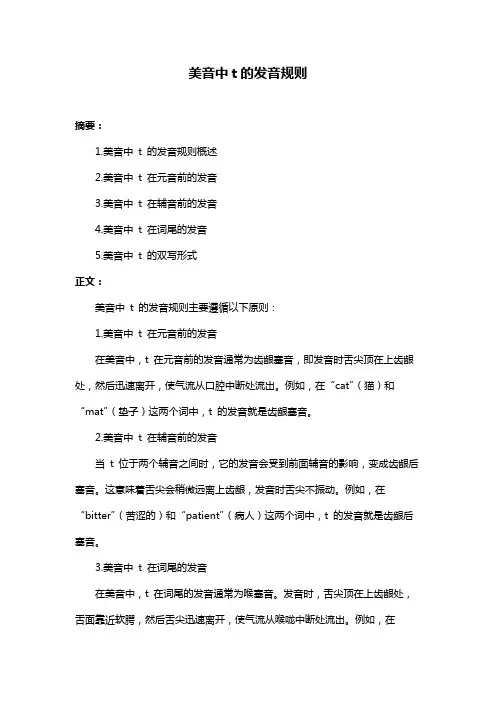
美音中t的发音规则摘要:1.美音中t 的发音规则概述2.美音中t 在元音前的发音3.美音中t 在辅音前的发音4.美音中t 在词尾的发音5.美音中t 的双写形式正文:美音中t 的发音规则主要遵循以下原则:1.美音中t 在元音前的发音在美音中,t 在元音前的发音通常为齿龈塞音,即发音时舌尖顶在上齿龈处,然后迅速离开,使气流从口腔中断处流出。
例如,在“cat”(猫)和“mat”(垫子)这两个词中,t 的发音就是齿龈塞音。
2.美音中t 在辅音前的发音当t 位于两个辅音之间时,它的发音会受到前面辅音的影响,变成齿龈后塞音。
这意味着舌尖会稍微远离上齿龈,发音时舌尖不振动。
例如,在“bitter”(苦涩的)和“patient”(病人)这两个词中,t 的发音就是齿龈后塞音。
3.美音中t 在词尾的发音在美音中,t 在词尾的发音通常为喉塞音。
发音时,舌尖顶在上齿龈处,舌面靠近软腭,然后舌尖迅速离开,使气流从喉咙中断处流出。
例如,在“cat”(猫)和“hat”(帽子)这两个词中,t 的发音就是喉塞音。
4.美音中t 的双写形式在某些情况下,美音中t 会以双写的形式出现,即“tt”。
在这种情况下,两个t 的发音通常相同,都为齿龈塞音。
例如,在“letter”(信件)和“better”(更好的)这两个词中,tt 的发音都是齿龈塞音。
总之,美音中t 的发音规则主要取决于它所在的发音环境。
在元音前,t 通常发音为齿龈塞音;在辅音前,t 会变成齿龈后塞音;而在词尾,t 通常发音为喉塞音。
另外,在特定情况下,t 会以双写的形式出现,但其发音仍然遵循上述规则。
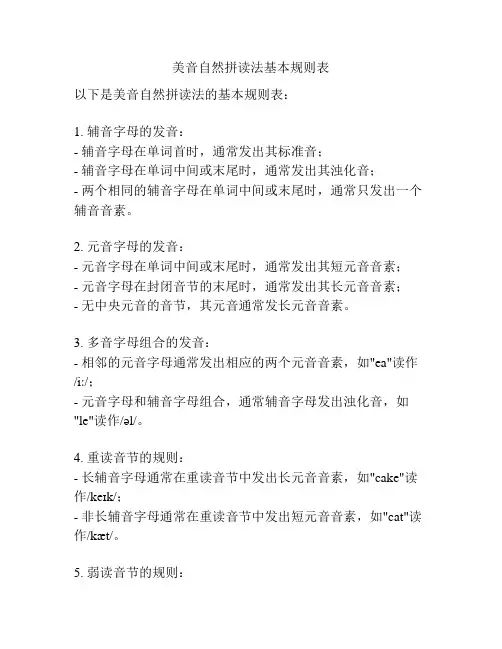
美音自然拼读法基本规则表
以下是美音自然拼读法的基本规则表:
1. 辅音字母的发音:
- 辅音字母在单词首时,通常发出其标准音;
- 辅音字母在单词中间或末尾时,通常发出其浊化音;
- 两个相同的辅音字母在单词中间或末尾时,通常只发出一个辅音音素。
2. 元音字母的发音:
- 元音字母在单词中间或末尾时,通常发出其短元音音素;- 元音字母在封闭音节的末尾时,通常发出其长元音音素;- 无中央元音的音节,其元音通常发长元音音素。
3. 多音字母组合的发音:
- 相邻的元音字母通常发出相应的两个元音音素,如"ea"读作/iː/;
- 元音字母和辅音字母组合,通常辅音字母发出浊化音,如"le"读作/əl/。
4. 重读音节的规则:
- 长辅音字母通常在重读音节中发出长元音音素,如"cake"读作/keɪk/;
- 非长辅音字母通常在重读音节中发出短元音音素,如"cat"读作/kæt/。
5. 弱读音节的规则:
- 弱读音节通常发出弱化元音音素,如"of"读作/əv/;
- 强读音节通常发出正常的元音音素。
这些规则只是美音自然拼读法的基础,实际应用中还可能有一些特例和例外情况。
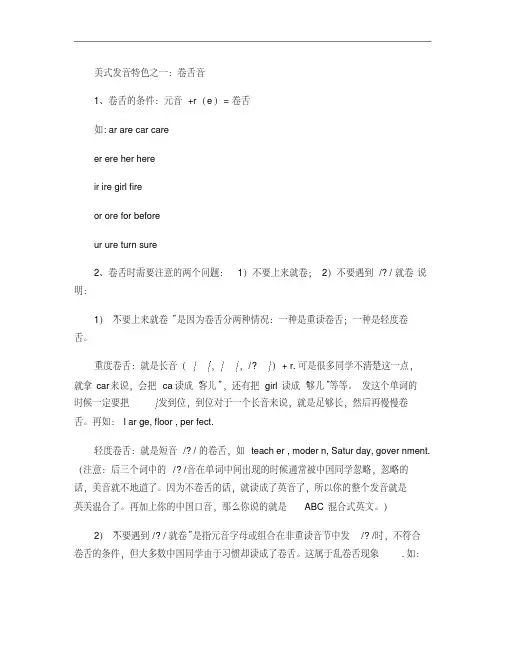
美式发音特色之一:卷舌音
1、卷舌的条件:元音+r(e )= 卷舌
如: ar are car care
er ere her here
ir ire girl fire
or ore for before
ur ure turn sure
2、卷舌时需要注意的两个问题:1)不要上来就卷;2)不要遇到 /?/ 就卷说明:
1)“不要上来就卷”是因为卷舌分两种情况:一种是重读卷舌;一种是轻度卷
舌。
重度卷舌:就是长音(,,/?)+ r. 可是很多同学不清楚这一点,
就拿 car 来说,会把ca 读成“客儿”,还有把girl 读成“够儿”等等。
发这个单词的
时候一定要把发到位,到位对于一个长音来说,就是足够长,然后再慢慢卷
舌。
再如:l ar ge, floor , per fect.
轻度卷舌:就是短音/?/ 的卷舌,如teach er , moder n, Satur day, gover nment. (注意:后三个词中的/?/音在单词中间出现的时候通常被中国同学忽略,忽略的
话,美音就不地道了。
因为不卷舌的话,就读成了英音了,所以你的整个发音就是
英美混合了。
再加上你的中国口音,那么你说的就是ABC 混合式英文。
)
2)“不要遇到/?/ 就卷”是指元音字母或组合在非重读音节中发/?/时,不符合
卷舌的条件,但大多数中国同学由于习惯却读成了卷舌。
这属于乱卷舌现象. 如:。
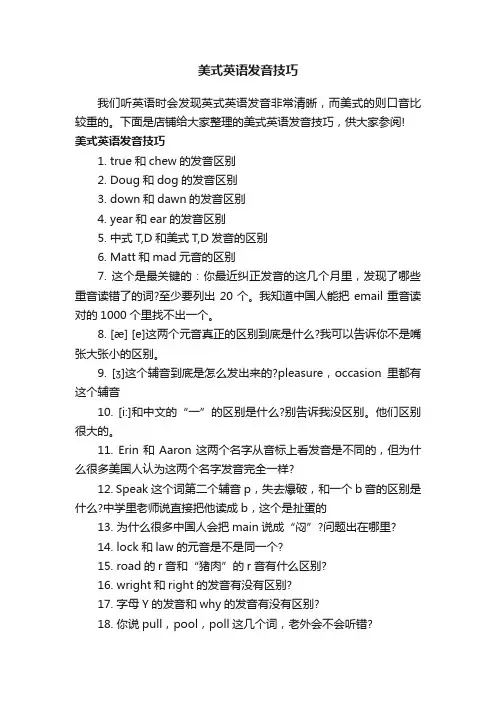
美式英语发音技巧我们听英语时会发现英式英语发音非常清晰,而美式的则口音比较重的。
下面是店铺给大家整理的美式英语发音技巧,供大家参阅! 美式英语发音技巧1. true和chew的发音区别2. Doug和dog的发音区别3. down和dawn的发音区别4. year和ear的发音区别5. 中式T,D和美式T,D发音的区别6. Matt和mad元音的区别7. 这个是最关键的:你最近纠正发音的这几个月里,发现了哪些重音读错了的词?至少要列出20个。
我知道中国人能把email重音读对的1000个里找不出一个。
8. [æ] [e]这两个元音真正的区别到底是什么?我可以告诉你不是嘴张大张小的区别。
9. [ʒ]这个辅音到底是怎么发出来的?pleasure,occasion里都有这个辅音10. [i:]和中文的“一”的区别是什么?别告诉我没区别。
他们区别很大的。
11. Erin和Aaron这两个名字从音标上看发音是不同的,但为什么很多美国人认为这两个名字发音完全一样?12. Speak这个词第二个辅音p,失去爆破,和一个b音的区别是什么?中学里老师说直接把他读成b,这个是扯蛋的13. 为什么很多中国人会把main说成“闷”?问题出在哪里?14. lock和law的元音是不是同一个?15. road的r音和“猪肉”的r音有什么区别?16. wright和right的发音有没有区别?17. 字母Y的发音和why的发音有没有区别?18. 你说pull,pool,poll这几个词,老外会不会听错?美式英语发音方法首先,美式发音中的r,是一个标志。
在美语中,字母R就从来没有不发音的。
而在英式英语,澳洲英语中常常是不震动声带发音的。
在美式发音中,字母R相当一个卷舌音的发音标志。
它在下面几种情况下会出现:第一,当字母R出现在最后一个字母位置的时候,要发卷舌音。
比如:teacher,car,four第二,当字母R的后面紧跟一个辅音字母的时候,这里的R要发音/r/,比如heard,learn美式发音中的第二个特征,是关于美式浊化音。
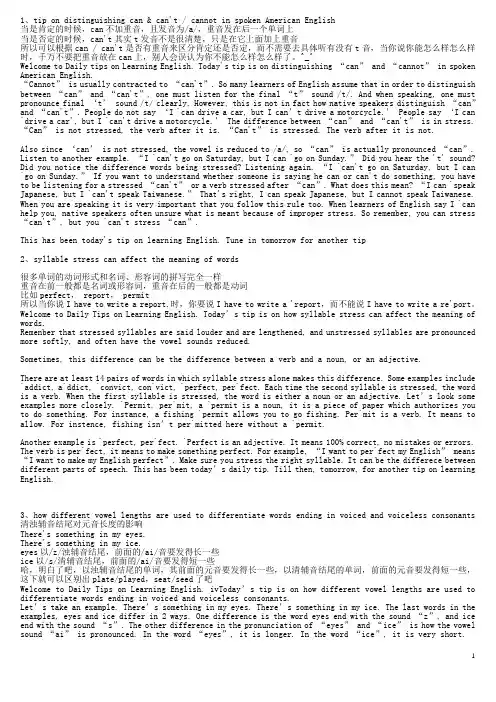
1、tip on distinguishing can & can't / cannot in spoken American English当是肯定的时候,can不加重音,且发音为/a/,重音发在后一个单词上当是否定的时候,can't其实t发音不是很清楚,只是在它上面加上重音所以可以根据can / can't是否有重音来区分肯定还是否定,而不需要去具体听有没有t音,当你说你能怎么样怎么样时,千万不要把重音放在can上,别人会误认为你不能怎么样怎么样了。
^_^Welcome to Daily tips on Learning English. Today's tip is on distinguishing “can” and “cannot” in spoken American English.“Cannot” is usually contracted to “can't”. So many learners of English assume that in order to distinguish between “can” and “can't”, one must listen for the final “t” sound /t/. And when speaking, one must pronounce final ‘t’ sound /t/ clearly. However, this is not in fact how native speakers distinguish “can”and “can't”. People do not say ‘I `can drive a car, but I can’t drive a motorcycle.’ People say ‘I can `drive a car', but I `can't drive a motorcycle.’ The difference between “can” and “can't” is in stress. “Can” is not stressed, the verb after it is. “Can't” is stressed. The verb after it is not.Also since ‘can’ is not stressed, the vowel is reduced to /a/, so “can” is actually pronounced “can”. Listen to another example. “I `can't go on Saturday, but I can `go on Sunday.” Did you hear the 't' sound? Did you notice the difference words being stressed? Listening again. “I `can't go on Saturday, but I can `go on Sunday.” If you want to understand whether someone is saying he can or can't do something, you have to be listening for a stressed “can't” or a verb stressed after “can”. What does this mean? “I can `speak Japanese, but I `can't speak Taiwanese.” That's right, I can speak Japanese, but I cannot speak Taiwanese. When you are speaking it is very important that you follow this rule too. When learners of English say I `can help you, native speakers often unsure what is meant because of improper stress. So remember, you can stress “can't”, but you `can't stress “can”.This has been today's tip on learning English. Tune in tomorrow for another tip2、syllable stress can affect the meaning of words很多单词的动词形式和名词、形容词的拼写完全一样重音在前一般都是名词或形容词,重音在后的一般都是动词比如perfect, report, permit所以当你说I have to write a report.时,你要说I have to write a 'report,而不能说I have to write a re'port。

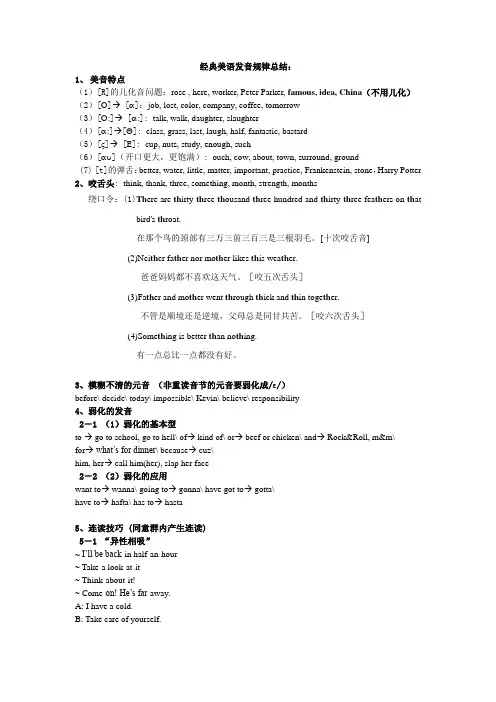
经典美语发音规律总结:1、美音特点(1)[R]的儿化音问题:rose , here, worker, Peter Parker, famous, idea, China(不用儿化)(2)[O]→ [α]:job, lost, color, company, coffee, tomorrow(3)[O:]→ [α:]: talk, walk, daughter, slaughter(4)[α:]→[Θ]: class, grass, last, laugh, half, fantastic, bastard(5)[ς]→ [E]: cup, nuts, study, enough, such(6)[αυ](开口更大,更饱满): ouch, cow, about, town, surround, ground(7) [t]的弹舌:better, water, little, matter, important, practice, Frankenstein, stone,Harry Potter 2、咬舌头: think, thank, three, something, month, strength, months绕口令:(1)Th ere are th irty-th ree th ousand th ree hundred and th irty-th ree fea th ers on th at bird's th roat.在那个鸟的颈部有三万三前三百三是三根羽毛。
[十次咬舌音](2)Nei th er fa th er nor mo th er likes th is wea th er.爸爸妈妈都不喜欢这天气。
[咬五次舌头](3)Fa th er and mo th er went th rough th ick and th in toge th er.不管是顺境还是逆境,父母总是同甘共苦。

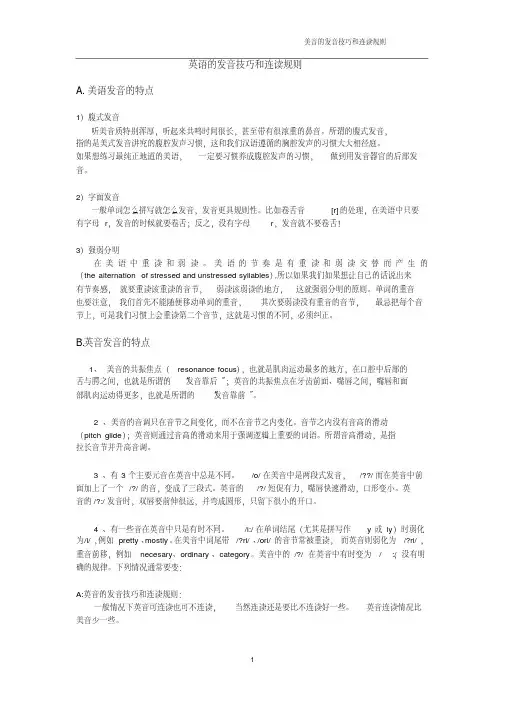
英语的发音技巧和连读规则A.美语发音的特点1)腹式发音听美音质特别浑厚,听起来共鸣时间很长,甚至带有很浓重的鼻音。
所谓的腹式发音,指的是美式发音讲究的腹腔发声习惯,这和我们汉语遵循的胸腔发声的习惯大大相径庭。
如果想练习最纯正地道的美语,一定要习惯养成腹腔发声的习惯,做到用发音器官的后部发音。
2)字面发音一般单词怎么拼写就怎么发音,发音更具规则性。
比如卷舌音[r]的处理,在美语中只要有字母r,发音的时候就要卷舌;反之,没有字母r,发音就不要卷舌!3)强弱分明在美语中重读和弱读。
美语的节奏是有重读和弱读交替而产生的(the alternation of stressed and unstressed syllables),所以如果我们如果想让自己的话说出来有节奏感,就要重读该重读的音节,弱读该弱读的地方,这就强弱分明的原则。
单词的重音也要注意,我们首先不能随便移动单词的重音,其次要弱读没有重音的音节,最忌把每个音节上,可是我们习惯上会重读第二个音节,这就是习惯的不同,必须纠正。
B.英音发音的特点1、美音的共振焦点(resonance focus),也就是肌肉运动最多的地方,在口腔中后部的舌与腭之间,也就是所谓的“发音靠后”;英音的共振焦点在牙齿前面、嘴唇之间,嘴唇和面部肌肉运动得更多,也就是所谓的“发音靠前”。
2、美音的音调只在音节之间变化,而不在音节之内变化。
音节之内没有音高的滑动(pitch glide);英音则通过音高的滑动来用于强调逻辑上重要的词语。
所谓音高滑动,是指拉长音节并升高音调。
3、有3个主要元音在英音中总是不同。
/o/在美音中是两段式发音,/??/而在英音中前面加上了一个/?/的音,变成了三段式。
英音的/?/短促有力,嘴唇快速滑动,口形变小。
英音的/?:/发音时,双唇要前伸很远,并弯成圆形,只留下很小的开口。
4、有一些音在英音中只是有时不同。
/i:/在单词结尾(尤其是拼写作y或ly)时弱化为/i/,例如pretty、mostly。
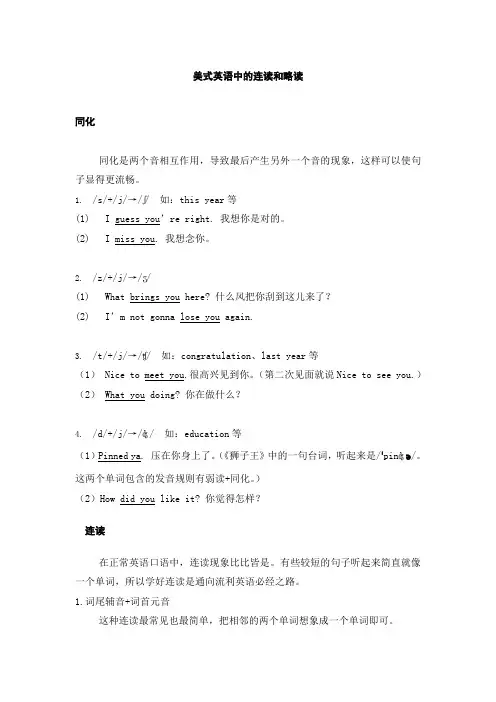
美式英语中的连读和略读同化同化是两个音相互作用,导致最后产生另外一个音的现象,这样可以使句子显得更流畅。
1./s/+/j/→/ʃ/ 如:this year等(1)I guess you’re right. 我想你是对的。
(2)I miss you. 我想念你。
2./z/+/j/→/ʒ/(1)What brings you here? 什么风把你刮到这儿来了?(2)I’m not gonna lose you again.3./t/+/j/→/ʧ/ 如:congratulation、last year等(1) Nice to meet you.很高兴见到你。
(第二次见面就说Nice to see you.)(2) What you doing? 你在做什么?4./d/+/j/→/ʤ/ 如:education等(1)Pinned ya. 压在你身上了。
(《狮子王》中的一句台词,听起来是/ˈpinʤə/。
这两个单词包含的发音规则有弱读+同化。
)(2)How did you like it? 你觉得怎样?连读在正常英语口语中,连读现象比比皆是。
有些较短的句子听起来简直就像一个单词,所以学好连读是通向流利英语必经之路。
1.词尾辅音+词首元音这种连读最常见也最简单,把相邻的两个单词想象成一个单词即可。
(1) I’m so fed up with him. 他让我烦透了。
(2) I’ve already made up my mind. 我意已决。
(3) That is so gross [ɡrəus].太俗了。
(4) Turn on the juice. 合上开关,恢复通电。
(juice也有电的意思)2.词尾元音+词首元音A:以/u/、/ʊ/、/au/、/o/结尾的单词与跟在后面的元音连读时,两个元音之间加上一个较轻的/w/,这样过渡就会很自然。
(1) Just do it. 尽管去做吧!(2) It’s snowing. 下雪了。
美音发音规则美音的发音规则是一项非常复杂的主题,不过我们可以从以下几个方面来介绍:1. 元音音标在美音中,元音音标的发音与汉语不同。
例如,a在美音中的发音类似汉语中的“呀”,e在美音中的发音类似汉语中的“额”,i在美音中的发音类似汉语中的“衣”,o在美音中的发音类似汉语中的“哦”,u在美音中的发音类似汉语中的“乌”。
2. 辅音音标在美音中,辅音音标的发音同样也与汉语有所不同。
例如,b在美音中的发音有气息,类似吐气音;c在美音中通常发s的音;f在美音中的发音比较轻盈,嘴唇要张得很大;j在美音中通常发dzh的音;r在美音中的发音比较特殊,需要舌尖抖动;v在美音中的发音类似汉语的“微”,舌头要贴在上齿龈上;z在美音中有时会发dz的音。
3. 连读和弱读美音的音节非常强调连读和弱读。
在连读中,辅音和元音连读在一起,形成一个音。
例如,“I am”在快速口音中常常发成“ahm”。
在弱读中,不重要的单词或音节会被省略或轻读。
例如,“to”这个单词在弱读时通常发成“ta”。
4. 重音在美音中,有些音节会发重音,而有些则发轻音。
重音通常会放在单词的第一个音节上,但也有例外。
例如,“picture”这个单词的重音在第二个音节上。
5. 浊音和清音在美音中,辅音可以被划分为浊音和清音。
浊音通常带有气息,例如b、g和d等。
清音则没有气息,例如p、k和t等。
总之,美音的发音规则非常繁琐,需要大量练习才能掌握。
但只要你能花时间去练习和听原版美剧,相信你也能成为一名擅长美音发音的人!。
一、长元音和双元音饱满鬼鬼祟祟的英文就是鬼鬼祟祟(sneaky; lousy)的元音造成的!只要把元音发饱满(full; plump),你的英语立刻会变得悦耳动听。
那些英美流行歌手就是元音饱满的典范!1. Mike likes to write by the nice bright light at night.麦克喜欢在夜晚明亮的灯光旁写作。
〔八次疯狂张嘴,元音极其饱满!〕2. Macao came back to China in 1999.澳门于1999年回归祖国。
3. I like the shape of that mountain.我喜欢那座山的样子。
〔包含了四个容易混淆的元音:形容山水最恰当!〕二、短元音急促有力4. Jim must study a little bit more.杰姆必须再多一下一点功夫。
5. Let's get together again.让我们找一天再聚一聚。
三、连音6. I'm working on-it.我正在努力。
〔美国总统常用〕7. I'll think-it-over.我会仔细考虑的。
四、略音第一条规则:以某音结尾的单词+同音开始的单词--只发一次即可!8. You ate-too much.你吃得太多了。
9. I don't know what-to-do.我不知道该做些什么。
〔两个辅音连接,只读后一个〕第二条规则:以〔t〕,〔d〕,〔k〕,〔g〕,〔p〕和〔b〕+以辅音开始的单词前面的发音“点到为止”,舌头达到发音中位,但不送气!10. Lend-me your black-bag.把你的黑包借给我。
11. I don't-like-people asking me for money.我不喜欢别人问我要钱。
12. Do you want-that-magazine?你要那本杂志吗?13. Do you need-that-pencil?你需要那只铅笔吗?14. Ask-Bob-to sit-behind-me.让鲍勃坐在我后面。
美国英语发音技巧大全ALBEE’S一、连读连读有两种规则,分别为:1、以辅音结尾的单词+元音开头的单词:如:(1)I’d li(ke a)nother bow(l o)f rice. 这里like / laik / 以辅音结尾,another 以元音开头,所以连读;(2)We have an English friend. 这个句子有两处连读:前一处是have的尾辅音/v/与an的开头元音//连读为/v/;后一处是an的尾辅音/n/与English的开头音素/i/连读为/ni/。
举例:I’m~an~English boy. It~is~an~old book. Let me have~a look~at~it.Ms Black worked in~an~office last~yesterday. I called~you half~an~hour~ago.Put~it~on, please. Not~at~all. Please pick~it~up.注意:以辅音结尾指的是音标中的最后一个音是辅音,而不是单词的结尾,这如同u[ju:.]niversity前面的定冠词必须用a 一样。
2、以辅音结尾的单词+ h开头的单词h不发音,与前面的辅音连读what wil(l he) [wili]do? Ha(s he) done it before? Mus(t he) [ti] go?Can he do it? Should he….?T ell him to ask her…. Lea(ve him) [vim]. For him (连读这个词,会发现和forum 很相似)3、以-r或-re字母结尾的单词+元音开头的单词时,可将/r/与后面的元音拼读。
如:They looked for it here and there.这个句子也有两处连读:前一处是for it合读为/frit/,后一处是here and合读为/hirnd/。
美音中t的发音规则(原创版)目录1.美音中 t 的发音规则概述2.美音中 t 在单词开头的发音规则3.美音中 t 在单词中间的发音规则4.美音中 t 在单词结尾的发音规则5.练习和注意事项正文美音中 t 的发音规则主要分为三种情况:在单词开头、中间和结尾。
掌握这些发音规则,可以帮助我们更准确地发音,提高英语听说能力。
首先,我们来看美音中 t 在单词开头的发音规则。
在这种情况下,t 的发音通常为清辅音,即声带不振动。
例如,单词“table”(桌子)中的t 发音就是清辅音。
其次,美音中 t 在单词中间的发音规则。
在这种情况下,t 的发音也会受到前后音的影响。
如果前面的音是元音,那么 t 的发音通常为浊辅音,即声带振动。
例如,在单词“bat”(蝙蝠)中,t 的发音就是浊辅音。
而如果前面的音是辅音,t 的发音通常为清辅音。
例如,在单词“cat”(猫)中,t 的发音就是清辅音。
接着,我们来看美音中 t 在单词结尾的发音规则。
在这种情况下,t 的发音一般为清辅音,即声带不振动。
例如,在单词“dog”(狗)和“pen”(笔)中,t 的发音都是清辅音。
在实际应用中,我们需要通过大量的练习来熟悉和掌握美音中 t 的发音规则。
在练习过程中,要注意以下几点:1.注意观察 t 在单词中的位置,根据不同位置的发音规则进行发音。
2.保持发音准确,避免因为不正确的发音而影响沟通。
3.多听、多说、多练,提高自己的英语听说能力。
通过以上介绍,相信你对美音中 t 的发音规则已经有了一定的了解。
美式发音技巧大全美式发音是全球英语学习者最为关注的一个问题,因为美音被认为是非常标准和地道的英语发音。
下面是一些美式发音的技巧和练习,希望对您的学习有所帮助。
1.需要掌握的音标学习美式发音首先要掌握国际音标,包括元音和辅音的发音。
熟练掌握音标可以帮助您迅速准确地学习新单词的发音。
2.注意长短元音的区分美式发音中有很多长短元音的区别,例如"bit"和"beat"的/i/音,"pull"和"pool"的/u/音。
要注意这些区别,听声音并模仿练习。
3.呼吸控制和声音发出的位置在发音时要注意呼吸的控制和声音发出的位置。
要保持一个稳定的呼吸节奏,并将声音放在正确的位置,通常是发声口腔的最前面。
4.捣糨糊练习"糨糊"是一种用来训练声音流畅度和连音的练习方法。
选择两个音节相连的两个单词,如"cat"和"dog",然后将它们连接起来变成一个单词"catdog"来练习发音。
5.重音和节奏美式英语重音和节奏的规律是不同于其他英语种类的,要注意单词中的重音部分,并且掌握英语句子的正确语调和节奏。
6.单词的连读美式英语中的连读是非常常见的现象,例如“gonna”代表“going to”,“wanna”代表“want to”。
要学会这些常用的连读并在口语中灵活运用。
7.音调的提升和降低美式英语中,有时需要将音调提高或降低来加强语气或表示语句的结束。
要学会掌握这种提升和降低的技巧,并在适当的场合使用。
8.非母语发音纠正如果您是非母语的英语学习者,那么可能会有一些母语干扰的发音问题。
要通过听力训练和模仿美式发音来纠正这些问题,比如发/s/音时不带浊音。
9.监听和模仿听力训练是提高发音的关键。
要多听美式英语的录音和美国人的口语,然后模仿他们的发音。
可以选取一些短语或句子作为模型,并不断练习。
矿产资源开发利用方案编写内容要求及审查大纲
矿产资源开发利用方案编写内容要求及《矿产资源开发利用方案》审查大纲一、概述
㈠矿区位置、隶属关系和企业性质。
如为改扩建矿山, 应说明矿山现状、
特点及存在的主要问题。
㈡编制依据
(1简述项目前期工作进展情况及与有关方面对项目的意向性协议情况。
(2 列出开发利用方案编制所依据的主要基础性资料的名称。
如经储量管理部门认定的矿区地质勘探报告、选矿试验报告、加工利用试验报告、工程地质初评资料、矿区水文资料和供水资料等。
对改、扩建矿山应有生产实际资料, 如矿山总平面现状图、矿床开拓系统图、采场现状图和主要采选设备清单等。
二、矿产品需求现状和预测
㈠该矿产在国内需求情况和市场供应情况
1、矿产品现状及加工利用趋向。
2、国内近、远期的需求量及主要销向预测。
㈡产品价格分析
1、国内矿产品价格现状。
2、矿产品价格稳定性及变化趋势。
三、矿产资源概况
㈠矿区总体概况
1、矿区总体规划情况。
2、矿区矿产资源概况。
3、该设计与矿区总体开发的关系。
㈡该设计项目的资源概况
1、矿床地质及构造特征。
2、矿床开采技术条件及水文地质条件。